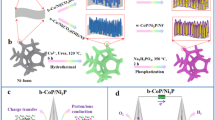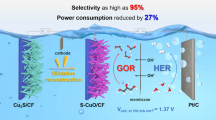Abstract
Dual-doping of carbon, especially the combination of nitrogen and a secondary heteroatom, has been demonstrated efficient to optimize the oxygen reduction reaction (ORR) performance. However, the optimum dual-doping is still not clear due to the lack of strong experimental proofs, which rely on a reliable method to prepare carbon materials that can rule out the interference factors and then emphasize only the doping effects. In this work, an inside-out doping method is reported to prepare carbon submicrotubes (CSTs) as a material to study the principles of designing dual-doping catalysts for ORR. The interference factors including the metal impurities and doping gradient in the bulk phase are excluded, and the doping effects including the structural and chemical variation of carbon are studied. P-doping exhibited a higher pore-forming ability to perforate carbon and a lower doping content, but a higher ORR catalytic activity as compared with S- and B-doped N-CSTs, demonstrating the N,P co-doping is more efficient in making carbon-based catalysts for ORR. First-principle calculations reveal that the edge C situated around the oxidized P site nearby a graphitic N atom is the active site that shows the lowest ORR overpotential comparable to Pt-based catalysts. This study suggests that the catalytic activity of dual-heteroatoms-doped carbons not only depends on the intrinsic chemical bonding between heteroatoms and carbon, but also is affected by the structural variation generated by introducing different atoms, which can be extended to the study of other kinds of functionalization of carbon and potential reactions besides ORR.

Similar content being viewed by others
References
Seh, Z. W.; Kibsgaard, J.; Dickens, C. F.; Chorkendorff, I.; Nørskov, J. K.; Jaramillo, T. F. Combining theory and experiment in electrocatalysis: Insights into materials design. Science 2017, 355, eaad4998.
Electrocatalysis for the generation and consumption of fuels. Nat. Rev. Chem. 2018, 2, 0125.
Yi, J.; Liang, P. C.; Liu, X. Y.; Wu, K.; Liu, Y. Y.; Wang, Y. G.; Xia, Y. Y.; Zhang, J. J. Challenges, mitigation strategies and perspectives in development of zinc-electrode materials and fabrication for rechargeable zinc-air batteries. Energy Environ. Sci. 2018, 11, 3075–3095.
Stephens, I. E. L.; Bondarenko, A. S.; Grønbjerg, U.; Rossmeisl, J.; Chorkendorff, I. Understanding the electrocatalysis of oxygen reduction on platinum and its alloys. Energy Environ. Sci. 2012, 5, 6744–6762.
He, W. H.; Wang, Y.; Jiang, C. H.; Lu, L. H. Structural effects of a carbon matrix in non-precious metal O2-reduction electrocatalysts. Chem. Soc. Rev. 2016, 45, 2396–2409.
Zhao, Z. P.; Chen, C. L.; Liu, Z. Y.; Huang, J.; Wu, M. H.; Liu, H. T.; Li, Y. J.; Huang, Y. Pt-based nanocrystal for electrocatalytic oxygen reduction. Adv. Mater. 2019, 31, 1808115.
Feng, S. Q.; Liu, C.; Chai, Z. G.; Li, Q.; Xu, D. S. Cobalt-based hydroxide nanoparticles@N-doping carbonic frameworks core-shell structures as highly efficient bifunctional electrocatalysts for oxygen evolution and oxygen reduction reactions. Nano Res. 2018, 11, 1482–1489.
Chung, H. T.; Cullen, D. A.; Higgins, D.; Sneed, B. T.; Holby, E. F.; More, K. L.; Zelenay, P. Direct atomic-level insight into the active sites of a high-performance PGM-free ORR catalyst. Science 2017, 357, 479–484.
Qu, L. T.; Liu, Y.; Baek, J. B.; Dai, L. M. Nitrogen-doped graphene as efficient metal-free electrocatalyst for oxygen reduction in fuel cells. ACS Nano 2010, 4, 1321–1326.
Lai, L. F.; Potts, J. R.; Zhan, D.; Wang, L.; Poh, C. K.; Tang, C. H.; Gong, H.; Shen, Z. X.; Lin, J. Y.; Ruoff, R. S. Exploration of the active center structure of nitrogen-doped graphene-based catalysts for oxygen reduction reaction. Energy Environ. Sci. 2012, 5, 7936–7942.
Singh, S. K.; Takeyasu, K.; Nakamura, J. Active sites and mechanism of oxygen reduction reaction electrocatalysis on nitrogen-doped carbon materials. Adv. Mater. 2019, 31, 1804297.
Tang, C.; Zhang, Q. Nanocarbon for oxygen reduction electrocatalysis: Dopants, edges, and defects. Adv. Mater. 2017, 29, 1604103.
To, J. W. F.; Ng, J. W. D.; Siahrostami, S.; Koh, A. L.; Lee, Y.; Chen, Z. H.; Fong, K. D.; Chen, S. C.; He, J. J.; Bae, W. G. et al. High-performance oxygen reduction and evolution carbon catalysis: From mechanistic studies to device integration. Nano Res. 2017, 10, 1163–1177.
Chen, L. L.; Xu, X. L.; Yang, W. X.; Jia, J. B. Recent advances in carbon-based electrocatalysts for oxygen reduction reaction. Chin. Chem. Lett. 2020, 31, 626–634.
Rao, C. V.; Cabrera, C. R.; Ishikawa, Y. In search of the active site in nitrogen-doped carbon nanotube electrodes for the oxygen reduction reaction. J. Phys. Chem. Lett. 2010, 1, 2622–2627.
Wu, J. J.; Ma, L. L.; Yadav, R. M.; Yang, Y. C.; Zhang, X.; Vajtai, R.; Lou, J.; Ajayan, P. M. Nitrogen-doped graphene with pyridinic dominance as a highly active and stable electrocatalyst for oxygen reduction. ACS Appl. Mater. Interfaces 2015, 7, 14763–14769.
Zhang, C. Z.; Hao, R.; Liao, H. B.; Hou, Y. L. Synthesis of aminofunctionalized graphene as metal-free catalyst and exploration of the roles of various nitrogen states in oxygen reduction reaction. Nano Energy 2013, 2, 88–97.
Geng, D. S.; Yang, S. L.; Zhang, Y.; Yang, J. L.; Liu, J.; Li, R. Y.; Sham, T. K.; Sun, X. L.; Ye, S. Y.; Knights, S. Nitrogen doping effects on the structure of graphene. Appl. Surf. Sci. 2011, 257, 9193–9198.
Gong, K. P.; Du, F.; Xia, Z. H.; Durstock, M.; Dai, L. M. Nitrogen-doped carbon nanotube arrays with high electrocatalytic activity for oxygen reduction. Science 2009, 323, 760–764.
Xu, J. J.; Xiao, C. H.; Ding, S. J. Red-blood-cell like nitrogen-doped carbons with highly catalytic activity towards oxygen reduction reaction. Chin. Chem. Lett. 2017, 28, 748–754.
Sun, T.; Wang, J.; Qiu, C. T.; Ling, X.; Tian, B. B.; Chen, W.; Su, C. L. B, N codoped and defect-rich nanocarbon material as a metal-free bifunctional electrocatalyst for oxygen reduction and evolution reactions. Adv. Sci. 2018, 5, 1800036.
Su, Y. Z.; Yao, Z. Q.; Zhang, F.; Wang, H.; Mics, Z.; Cánovas, E.; Bonn, M.; Zhuang, X. D.; Feng, X. L. Sulfur-enriched conjugated polymer nanosheet derived sulfur and nitrogen co-doped porous carbon nanosheets as electrocatalysts for oxygen reduction reaction and zinc-air battery. Adv. Funct. Mater. 2016, 26, 5893–5902.
Chai, G. L.; Qiu, K. P.; Qiao, M.; Titirici, M. M.; Shang, C. X.; Guo, Z. X. Active sites engineering leads to exceptional ORR and OER bifunctionality in P,N co-doped graphene frameworks. Energy Environ. Sci. 2017, 10, 1186–1195.
Zhang, J. T.; Zhao, Z. H.; Xia, Z. H.; Dai, L. M. A metal-free bifunctional electrocatalyst for oxygen reduction and oxygen evolution reactions. Nat. Nanotechnol. 2015, 10, 444–452.
Liang, J.; Jiao, Y.; Jaroniec, M.; Qiao, S. Z. Sulfur and nitrogen dual-doped mesoporous graphene electrocatalyst for oxygen reduction with synergistically enhanced performance. Angew. Chem., Int. Ed. 2012, 51, 11496–11500.
Wang, S. Y.; Zhang, L. P.; Xia, Z. H.; Roy, A.; Chang, D. W.; Baek, J. B.; Dai, L. M. BCN graphene as efficient metal-free electrocatalyst for the oxygen reduction reaction. Angew. Chem., Int. Ed. 2012, 51, 4209–4212.
Fu, S. F.; Zhu, C. Z.; Song, J. H.; Engelhard, M. H.; Li, X. L.; Zhang, P. N.; Xia, H. B.; Du, D.; Lin, Y. H. Template-directed synthesis of nitrogen- and sulfur-codoped carbon nanowire aerogels with enhanced electrocatalytic performance for oxygen reduction. Nano Res. 2017, 10, 1888–1895.
Wang, J.; Wu, Z. X.; Han, L. L.; Liu, Y. Y.; Guo, J. P.; Xin, H. L.; Wang, D. L. Rational design of three-dimensional nitrogen and phosphorus co-doped graphene nanoribbons/CNTs composite for the oxygen reduction. Chin. Chem. Lett. 2016, 27, 597–601.
Li, Y. G.; Zhou, W.; Wang, H. L.; Xie, L. M.; Liang, Y. Y.; Wei, F.; Idrobo, J. C.; Pennycook, S. J.; Dai, H. J. An oxygen reduction electrocatalyst based on carbon nanotube-graphene complexes. Nat. Nanotechnol. 2012, 7, 394–400.
Banks, C. E.; Crossley, A.; Salter, C.; Wilkins, S. J.; Compton, R. G. Carbon nanotubes contain metal impurities which are responsible for the “electrocatalysis” seen at some nanotube-modified electrodes. Angew. Chem., Int. Ed. 2006, 45, 2533–2537.
El-Sawy, A. M.; Mosa, I. M.; Su, D.; Guild, C. J.; Khalid, S.; Joesten, R.; Rusling, J. F.; Suib, S. L. Controlling the active sites of sulfur-doped carbon nanotube-graphene nanolobes for highly efficient oxygen evolution and reduction catalysis. Adv. Energy Mater. 2016, 6, 1501966.
Wu, G.; Mack, N. H.; Gao, W.; Ma, S. G.; Zhong, R. Q.; Han, J. T.; Baldwin, J. K.; Zelenay, P. Nitrogen-doped graphene-rich catalysts derived from heteroatom polymers for oxygen reduction in nonaqueous lithium-O2 battery cathodes. ACS Nano 2012, 6, 9764–9776.
Hao, L.; Ning, J.; Luo, B.; Wang, B.; Zhang, Y. B.; Tang, Z. H.; Yang, J. H.; Thomas, A.; Zhi, L. J. Structural evolution of 2D microporous covalent triazine-based framework toward the study of high-performance supercapacitors. J. Am. Chem. Soc. 2015, 137, 219–225.
Gao, Y.; Xiao, Z. C.; Kong, D. B.; Iqbal, R.; Yang, Q. H.; Zhi, L. J. N,P co-doped hollow carbon nanofiber membranes with superior mass transfer property for trifunctional metal-free electrocatalysis. Nano Energy 2019, 64, 103879.
Zhang, J. T.; Dai, L. M. Nitrogen, phosphorus, and fluorine tri-doped graphene as a multifunctional catalyst for self-powered electrochemical water splitting. Angew. Chem., Int. Ed. 2016, 55, 13296–13300.
Hu, C. G.; Dai, L. M. Multifunctional carbon-based metal-free electrocatalysts for simultaneous oxygen reduction, oxygen evolution, and hydrogen evolution. Adv. Mater. 2017, 29, 1604942.
Gong, Y. J.; Fei, H. L.; Zou, X. L.; Zhou, W.; Yang, S. B.; Ye, G. L.; Liu, Z.; Peng, Z. W.; Lou, J.; Vajtai, R. et al. Boron- and nitrogen-substituted graphene nanoribbons as efficient catalysts for oxygen reduction reaction. Chem. Mater. 2015, 27, 1181–1186.
Ci, L. J.; Song, L.; Jin, C. H.; Jariwala, D.; Wu, D. X.; Li, Y. J.; Srivastava, A.; Wang, Z. F.; Storr, K.; Balicas, L. et al. Atomic layers of hybridized boron nitride and graphene domains. Nat. Mater. 2010, 9, 430–435.
Wang, S. Y.; Iyyamperumal, E.; Roy, A.; Xue, Y. H.; Yu, D. S.; Dai, L. M. Vertically aligned BCN nanotubes as efficient metal-free electrocatalysts for the oxygen reduction reaction: a synergetic effect by co-doping with boron and nitrogen. Angew. Chem., Int. Ed. 2011, 50, 11756–11760.
Chen, S. C.; Chen, Z. H.; Siahrostami, S.; Higgins, D.; Nordlund, D.; Sokaras, D.; Kim, T. R.; Liu, Y. Z.; Yan, X. Z.; Nilsson, E. et al. Designing boron nitride islands in carbon materials for efficient electrochemical synthesis of hydrogen peroxide. J. Am. Chem. Soc. 2018, 140, 7851–7859.
Zheng, Y.; Jiao, Y.; Ge, L.; Jaroniec, M.; Qiao, S. Z. Two-step boron and nitrogen doping in graphene for enhanced synergistic catalysis. Angew. Chem., Int. Ed. 2013, 52, 3110–3116.
Liu, R. L.; Wu, D. Q.; Feng, X. L.; Müllen, K. Nitrogen-doped ordered mesoporous graphitic arrays with high electrocatalytic activity for oxygen reduction. Angew. Chem., Int. Ed. 2010, 49, 2565–2569.
Li, M. T.; Zhang, L. P.; Xu, Q.; Niu, J. B.; Xia, Z. H. N-doped graphene as catalysts for oxygen reduction and oxygen evolution reactions: Theoretical considerations. J. Catal. 2014, 314, 66–72.
Zhao, Z. H.; Li, M. T.; Zhang, L. P.; Dai, L. M.; Xia, Z. H. Design principles for heteroatom-doped carbon nanomaterials as highly efficient catalysts for fuel cells and metal-air batteries. Adv. Mater. 2015, 27, 6834–6840.
Nørskov, J. K.; Rossmeisl, J.; Logadottir, A.; Lindqvist, L.; Kitchin, J. R.; Bligaard, T.; Jónsson, H. Origin of the overpotential for oxygen reduction at a fuel-cell cathode. J. Phys. Chem. B 2004, 108, 17886–17892.
Zhang, L. P.; Xia, Z. H. Mechanisms of oxygen reduction reaction on nitrogen-doped graphene for fuel cells. J. Phys. Chem. C 2011, 115, 11170–11176.
Yang, N.; Li, L.; Li, J.; Ding, W.; Wei, Z. D. Modulating the oxygen reduction activity of heteroatom-doped carbon catalysts via the triple effect: Charge, spin density and ligand effect. Chem. Sci. 2018, 9, 5795–5804.
Acknowledgements
We acknowledge the financial support from the National Natural Science Foundation of China (No. 51425302).
Author information
Authors and Affiliations
Corresponding authors
Electronic Supplementary Material
12274_2021_3484_MOESM1_ESM.pdf
Inside-out dual-doping effects on tubular catalysts: Structural and chemical variation for advanced oxygen reduction performance
Rights and permissions
About this article
Cite this article
Gao, Y., Kong, D., Liang, J. et al. Inside-out dual-doping effects on tubular catalysts: Structural and chemical variation for advanced oxygen reduction performance. Nano Res. 15, 361–367 (2022). https://doi.org/10.1007/s12274-021-3484-y
Received:
Revised:
Accepted:
Published:
Issue Date:
DOI: https://doi.org/10.1007/s12274-021-3484-y




